Choosing and installing latches on interior doors
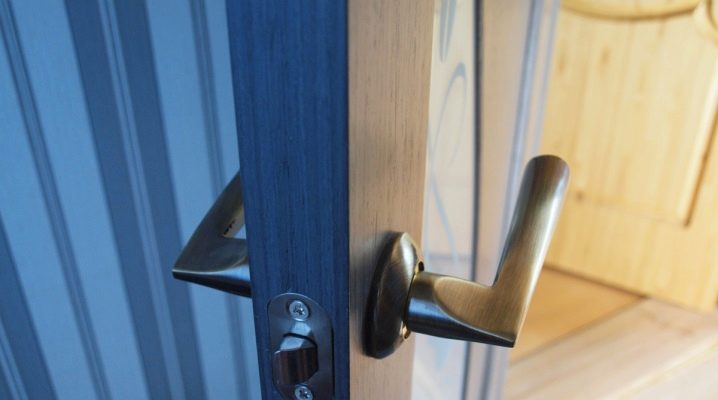
At the long-awaited final stage of the renovation, interior doors are being installed in the apartment. In most cases, there is simply no need to use locking locks for such doors. Therefore, the latches cut into the door leaf. The article will talk about the design and installation features of door latches with a latch.

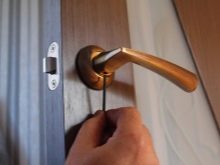

Features and varieties
Devices with a latch for interior doors by the type of installation are external and mortise. The first type of latches are much easier to install, assemble and disassemble if necessary. The downside is that they significantly spoil the appearance of the door leaf. Therefore, it is the mortise fixing mechanisms that are in the greatest demand.
Such latches for interior doors are presented on the market in a large assortment. Depending on the wishes and purpose, you can easily choose the optimal type of fixing device. According to the principle of operation and design features, mortise door latches are divided into several groups.
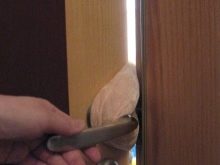
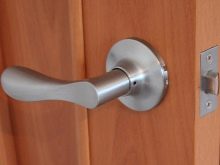

Magnetic
The door locking device consists of two parts: a metal plate and a magnetic element. The magnet and plate are placed on the side of the door leaf and on the jamb. The principle of operation of such a lock is very simple: when closing, the magnet attracts the metal element, thereby holding the door in a fixed closed position. A fixed handle is used to open doors with a magnetic locking element.
The second type of clamps of this type are models where the magnet is made in the form of a movable tongue. The advantage of such a latch is that it is practically silent. Its characteristics, such as smooth operation and long service life, are also in great demand and are convenient.
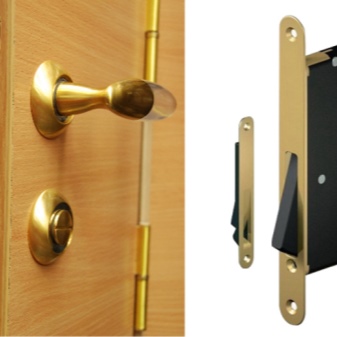

Fale
Such a mortise mechanism has a movable retractable tongue with angled contours. A plate with a groove is attached to the jamb. When closed, the tongue enters the groove and fixes the position of the door. Opening occurs when pressing on the movable handle, which leads to the extension of the tongue from the groove, releasing the door leaf from fixation.
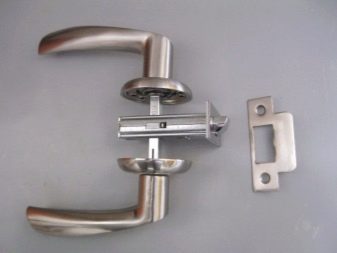

Roller
Instead of a tongue, these latches use a spring loaded roller. When closed, it enters a small recess and prevents the door from opening. Such latches can be set in motion by means of a stationary handle with the application of some force. There are also models that can be opened by pressing the lever handle.

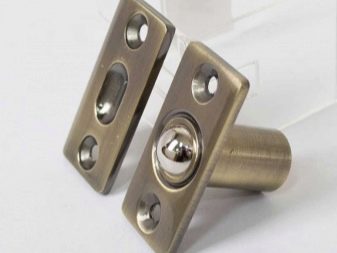
Latches with locking latch
Usually mechanisms of this type are installed on the door to the bathroom or the bathroom. Their peculiarity is that they are equipped with a special blocking element. When the block key is turned, the latch stops opening when you press the door handle. Thus, the room is protected from unwanted intrusion for a certain period of time.
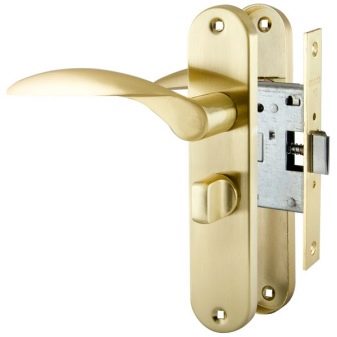
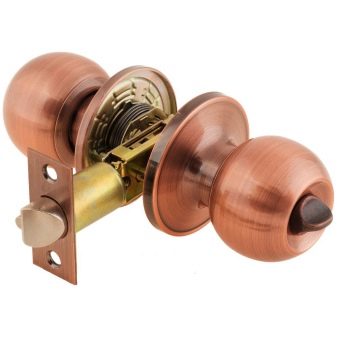
How to choose?
To purchase a quality interior door locking device, you should pay attention to the following criteria.
- The quality of the latch is evidenced by the smooth operation. During opening and closing, there should be no jams or clicks.
- It is best to choose a device with medium stiffness springs. Weak springs can eventually stop holding the door leaf, especially if it is quite heavy.And mechanisms with tight springs will require effort to open the door.
- Inspect the product carefully and evaluate its appearance. The body and parts should be free of scratches, cracks, chips, traces of chemical damage, rust, paint defects.
- Tactile perception is also important. The handle should be pleasant to the touch and fit comfortably in your hand.
- Try to find the specifications that best suit the operating conditions. For example, if the door leaf is very heavy and massive, you should choose a latch made of particularly durable materials. The data on the locking mechanism can be found in the product data sheet.
- It is best if handles and latches are made in the same style in an apartment or house. It is also important that this element matches the design of the doors. Interior designers do not recommend using latches, handles and hinges in different colors.
- Decide on the function that the locking mechanism should perform. For installation on a door to a bathroom or a bathroom, it is best to choose a lock with a latch. For the bedroom and children's room, a quiet magnetic lock would be a good option.
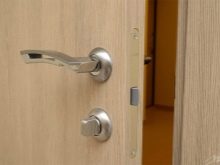

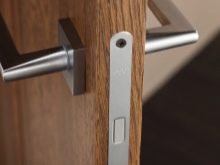
Self-installation
The installation of the latch into the door leaf is almost identical to the process of cutting in a conventional door lock. This work can be done with your own hands. The mechanism is installed in the door at a distance of 1 meter from the floor. It is at this height in the door leaf that there is a wooden bar, into which the fixing mechanism is installed.
To cut the device into an interior door, you will need the following tools and materials:
- drill and a set of drills (feather, wood);
- wood crowns;
- electric screwdriver or manual screwdriver;
- chisels, medium and narrow in width, a milling cutter is a good alternative for making a cut under the bar, but it is not found in every home set of tools;
- hammer;
- pencil;
- ruler or square;
- a knife for carpentry work or a sharp clerical.
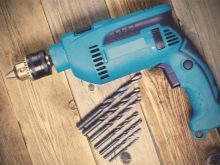
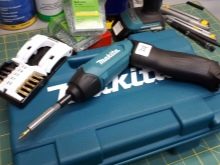

At the first stage, it is necessary to make markings on both sides of the door leaf. First, the height from the floor is measured, equal to 1 meter. Then the distance is set aside, corresponding to the size of the latch to be cut in. Most often, the locking mechanisms have a standardized height of 60 mm or 70 mm. For greater accuracy, it is better to attach the locking device itself to the door and mark its extreme values.
Next, you need to drill a wooden bar. To do this, select a tip drill that matches the size of the latch mechanism. You need to drill to the depth of the drill blade. The next step is to make a pothole for the plank. The procedure is performed using a chisel. Previously, the veneer from the door leaf must be removed with a sharp clerical knife.
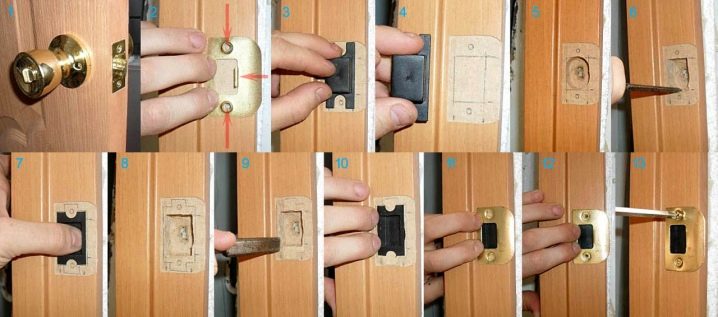
For the handle, you need to make a through hole in the bar. For this, a wood crown is used. A pothole is made from the end of the door for a tongue or roller latch. The cutouts are neatly aligned with a chisel. The device is installed in the door leaf. This must be done from the end of the door. The whole mechanism is fixed with screws or self-tapping screws.
The door handle is assembled into an installed and secured mechanism. You must first disassemble it. Next, you can install decorative overlays. The final stage of installing the door latch is to mount the striker on the jamb. To do this, close the door and mark the position of the locking tab or roller on the jamb. This mark needs to be transferred to the box.
You also need to measure the distance from the bottom edge of the pothole in the door rail to the center of the latch. Transfer the size to the opening box. According to the measurements obtained, cutouts are made for the tongue and striker. The strip is attached to the door frame with self-tapping screws.
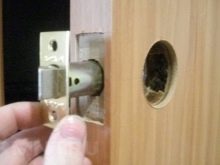
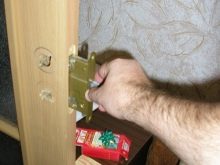
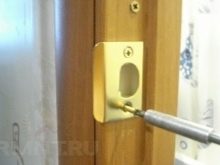
Disassembling the latch
There are situations when the dismantling of the locking door mechanism is required.Such a need may arise when the lock itself has fallen into disrepair, as well as when it needs to be replaced for external, aesthetic reasons. The procedure for disassembling the door locking mechanism, including the silent magnetic one, is not difficult to carry out.
First you need to grip the spring element well and gently slide the pin. Pull the handle towards you, but do not exert too much effort. If the spring is clamped with sufficient force, the handle will easily come out of the hole. Next, the slate latch and the handle with overlays must be removed. After the performed manipulations, it will not be difficult to untwist the fasteners. The entire device can be easily removed from the pothole in the timber.
How to install door handles on interior doors, see the video below.













The comment was sent successfully.